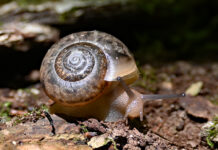
PLAIN CITY, Ohio — Water quality and cover crops were key topics at the Ohio No-Till Conference Dec. 7 in Plain City.
Bill Chain, director of the Chesapeake Bay Foundation, was invited to speak at the conference because farmers, mainly in Pennsylvania, Virginia and Maryland, played a leading role in setting policies and goals for the cleanup of Chesapeake Bay. They worked with “watermen” who harvest blue crabs and oysters, and recreational boaters to understand each other’s needs.
The Susquehanna River is the main source of fresh water for the bay, just as the Maumee River is for Lake Erie. Continuous no-till and cover crops have been adopted on most crop land in the Chesapeake Bay watershed, greatly reducing the amount of sediment (topsoil) and nutrients entering the Chesapeake Bay.
Chain, who lives near Lancaster, Pennsylvania, said he was surprised to see so much tilled ground as he drove to northwest Ohio, where he spoke at the Putnam County SWCD banquet, and then to Plain City for the Ohio No-Till Conference.
Continuous no-till and cover crops are keys to reducing the amount of phosphorus entering Lake Erie, which is a main cause of the algae problems.
Other speakers
Warren Dick, retired Ohio State University soil scientist, spoke on the dynamics of phosphorus in water and soil. Phosphorus fertilizer needs to be injected — instead of spread on the surface — and applied at the right rate to meet the needs of the crop. Gypsum can reduce by a third the amount of dissolved reactive P (DRP) leaving the field in surface runoff and tile discharge after two years of application.
Terry Mescher, an agricultural engineer with the Ohio Department of Agriculture, oversees the H2Ohio program. The goal is to reduce phosphorus entering Lake Erie by 40%. This translates to cutting about 800,000 pounds annually from leaving farm fields.
Questions and answers. An hour was devoted to questions from the audience. Serving on the panel to respond were Bill Chain, Bill Richards, Warren Dick, David Brandt and Cody Beacom. Dusty Sonnenberg and Randall Reeder moderated.
Most questions related to Lake Erie, federal policy and cover crops.
One question was, “Why aren’t no-till farmers with several years of sequestering carbon eligible for substantial carbon payments?”
The answer is that funding sources prefer to persuade farmers who plow every year to switch to continuous no-till and cover crops rather than pay no-till farmers to continue adding carbon deeper in their soil.
Mike Estadt added some details to the carbon question later in his talk on Carbon Programs.
Alyssa Essman shared information about which cover crops are most as risk of failure resulting from specific herbicides applied a few months earlier. She also discussed the growing problem of herbicide-resistant weeds and how cover crops can help suppress weeds.
Jim Hoorman described how micronutrient uptake can be enhanced with fulvic and humic acid. The identified micronutrients are only 2% of the total nutrients needed for plant growth and yield, but they’re essential. Fulvic acid speeds up biological processes by getting these micronutrients into a form that plants can use.
Ann Brandt, Walnut Creek Seeds, discussed how “Pure Live Seed” requirements for NRCS reimbursement for cover crops may require the farmer to buy a few more pounds of seed per acre than expected.
The Ohio No-Till Council presented awards in three categories. Tim Norris of Knox County received the Outstanding No-till Farmer Award.
Three organizations, American Farmland Trust, Ohio Soybean Council and Ohio Corn Marketing Program were recognized for their educational efforts and support of no-till and soil health. Tim Norris and representatives from each organization (Brian Brandt, Tom Fontana and Brad Moffitt) gave brief remarks.
The conference is held every year at the Der Dutchman Restaurant in Plain City. Information on the 2023 conference and several no-till field day events will be posted on the website OhioNoTillCouncil.com.










